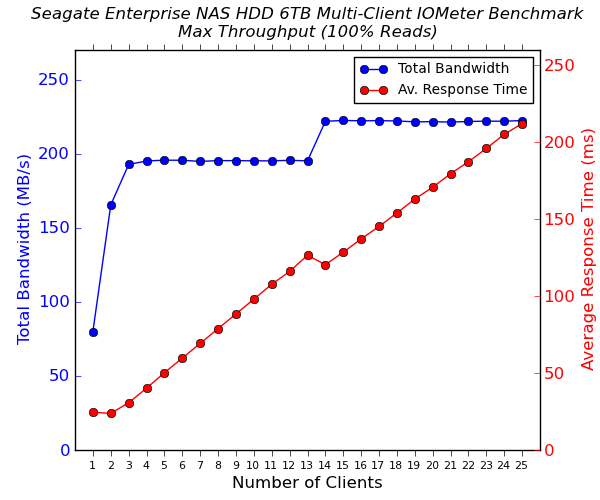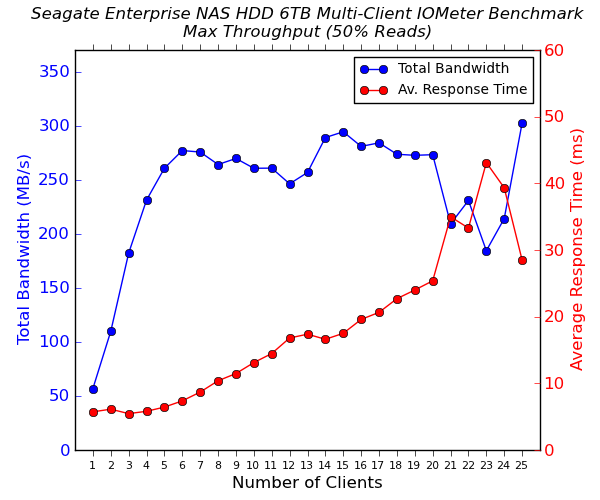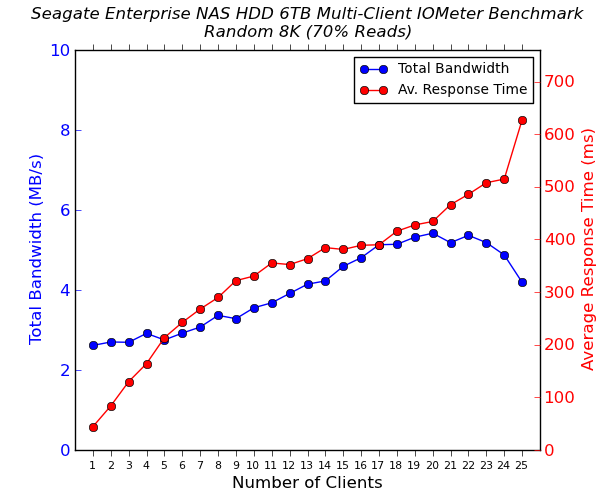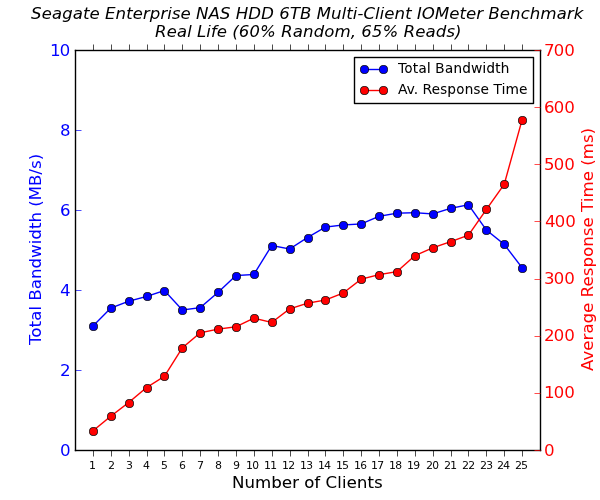Seagate Enterprise NAS HDD 6 TB Review
by Ganesh T S on December 10, 2014 8:00 AM EST- Posted in
- NAS
- Storage
- Seagate
- HDDs
- Enterprise
Multi-Client Access - NAS Environment
We configured three of the Seagate Enterprise NAS HDD drives in a RAID-5 volume in the QNAP TS-EC1279U-SAS-RP. A CIFS share in the volume was subject to some IOMeter tests with access from up to 25 VMs simultaneously. The following four graphs show the total available bandwidth and the average response time while being subject to different types of workloads through IOMeter. IOMeter also reports various other metrics of interest such as maximum response time, read and write IOPS, separate read and write bandwidth figures etc. Some of the interesting aspects from our IOMeter benchmarking run are available here.




We see that the sequential accesses are still limited by the network link, but, this time, on the NAS side. On the other hand, our random access tests show markedly better performance for enterprise drives. From a viewpoint of the average access times, the Seagate Enterprise Capacity v4, Seagate Enterprise NAS HDD and the HGST Ultrastar He6 all fall in the same category. Amongst these three, the Enterprise NAS HDD doesn't win out on any particular benchmark. However, that is to be expected - the other drives that are in the comparison list are targeted towards true enterprise-class / datacenter applications.










51 Comments
View All Comments
hlmcompany - Wednesday, December 10, 2014 - link
I can see that happening. I just never thought of IntelliPower as being such a thing. HDD's cannot vary their spindle speed during data access. A fixed spindle speed during operation is monitored by the drive, and if it changes, it is considered a major error. You'd actually hear the WD drive Click twice, and then read Track 0 in an attempt to re-calibrate it's position.extide - Wednesday, December 10, 2014 - link
This would be really easy to verify with a oscilloscope, just watch the waveforms going into the stepper motor... (But yeah, intellipower drives run at fixed speeds, although different models can run at different speeds than other models)MrSpadge - Wednesday, December 10, 2014 - link
Thanks.. that sounds better than their 1st explanations. Although I'd still prefer if they said straight "it's 5.4k rpm, give or take a few".hlmcompany - Wednesday, December 10, 2014 - link
Marketing.... *sigh*hlmcompany - Wednesday, December 10, 2014 - link
Seagate lists this drive as 7200 rpm, which matches its direct competitor, the WD Red Pro.Oyster - Wednesday, December 10, 2014 - link
Ganesh, I'll admit I didn't read between the lines, but why exclude the WD Red Pros from the analysis? Seems a bit out of place to compare an enterprise class HD to a non-enterprise class HD (WD Reds @ 5400 RPM, with 3 year warranty, lower MTBF)?MrSpadge - Wednesday, December 10, 2014 - link
Because there is no 6 TB Red Pro. Using 800 GB platters it already needs 5 of them to reach 4 TB and can not even reach 5 TB yet.MrSpadge - Wednesday, December 10, 2014 - link
Ganesh, in your conclusion you simply attribute the performance advantage of the Seagates to their larger cache. While the cache does help, it normally doesn't help a lot once you have enough of it. Otherwise we would see much larger caches already, as DRAM in the sub-GB range is really cheap, whereas we're talking about 500$ enterprise HDDs here.I suspect the larger platter density of the Seagates has more to do with their performance than the cache. Firmware also plays a major in real world HDD peformance.
ganeshts - Wednesday, December 10, 2014 - link
We observed similar performance advantages for the Seagate Enterprise Capacity v4 vs. the WD Red Pro at the 4 TB capacity point.Both of them use the same number of platters, have the same rotational speed. The only difference was the cache size.
That said, things are indeed different in this case - the WD Red has lower rotational speed, but does have higher platter density (1.2TB/platter) at the 6TB point. So, I should probably have not stressed the cache size differences too much (just had a hangover from the 4TB review)
MrSpadge - Wednesday, December 10, 2014 - link
The 4 TB Seagate Enterprise Capacity v4 also uses 1 TB platters, whereas the Red Pro uses 800 GB platters. Compare the sequential write speeds in MB/s (max - average - min):Red Pro 4 TB: 179 - 142 - 86
Ent. Cap. v4 4 TB: 210 - 166 - 97
Ent. Cap. v4 6 TB: 224 - 171 - 104
The Seagates perform almost identical, with a minor advantage for the 6 TB model. However, the Red Pro is significantly slower.